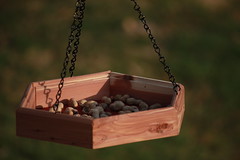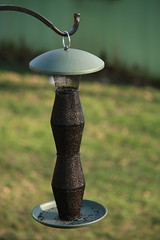Here is my setup in a little more detail....just to accurately describe what we are going for.
I have a couple of metal-mesh feeders. I am not fond of the damage all feeders inevitably face when it comes to squirrels. Don't get me wrong, I don't mind the squirrels at all. I love their antics around feeders. However, those little peskies chew and chew and chew on feeders to try and get the seed. If you are not taking ample measures to keep the squirrels at bay you will a) lose feeders to damage and b) spend a small fortune in seed.....enough to drive Bill Gates himself to bankruptcy. My longer term goal is to provide myself some entertainment when it comes to feeding squirrels, but more on that another time.
As for the set up, as you saw previously, I have purchased a long pole with four arms from which to hang feeders. My original plan was to hang two feeders and two hanging baskets with flowers in them. However, after needing a place to put my peanuts where squirrels cannot easily reach them, I decided to really combo up the feeder with the two seed feeders (sunflower and niger), a peanut tray, and a hummingbird feeder. I may move the hummer feeder to another location, but we'll see. First, it has to arrive via UPS.
What are the goals of these feeders? Well, let's run off a brief description of what the feeders attract one by one.
The sunflower feeder (tube type on left) is designed to attract general  songbirds like cardinals, finches, sparrows, jays, nuthatches, titmice, and chickadees to name just a few that reside in MY area. Sunflower Black oil sunflower seed is the most important seed in any backyard bird feeding plan. Almost any bird that visits a bird feeder will readily eat black oil sunflower seeds, and studies have shown that, given a choice of seeds, more species of birds will choose black oil sunflower seeds over any other food that is offered.
songbirds like cardinals, finches, sparrows, jays, nuthatches, titmice, and chickadees to name just a few that reside in MY area. Sunflower Black oil sunflower seed is the most important seed in any backyard bird feeding plan. Almost any bird that visits a bird feeder will readily eat black oil sunflower seeds, and studies have shown that, given a choice of seeds, more species of birds will choose black oil sunflower seeds over any other food that is offered.
The shell of the black oil sunflower seed is thin and easily broken by birds, even those with small beaks. Once opened, black oil sunflower seeds offer more nutrients than any other type of seed, a higher ratio of nutmeat to shell, and the quality of protein is among the highest of any plant food on earth.
The high oil content in black oil sunflower seed, along with the high fat content, provide instant energy for the birds that eat them - something that is of critical importance in winter bird-feeding. In addition, black oil sunflower seeds are high in fiber and contain Vitamin E, biotin, choline, thiamin, and zinc. (source: http://www.shawcreekbirdsupply.com/seed_black_oil_sunflower.htm)
The other tube feeder is filled with Nyjer seed (title pic of blog post). Nyjer is a tiny, thistle-type seed that the finches go crazy for. For more info look here... http://www.knoxnews.com/news/2009/feb/08/nyjer-seeds-suit-goldfinches-and-pine-siskins/
And, the peanut feeder is being used to get my Blue Jays out of the treetops and down where I  can photograph them. Granted, I may be creating more of a noise problem for my house than I want, I just haven't ever seen a feeder w/o these colorful guys close by. From what I have read, blue jays cannot resist a peanut, so I am giving these a go. Just today, though, I saw some Titmice robbing me blind of the peanuts. Quite a treat, however, and upon looking further I have found that these other birds will also dine on peanuts: Some finches, Titmice, Woodpeckers, some Wrens, Blue Jays, Indigo Buntings (which I would love to see), Cardinals, Chickadees, Grosbeaks (also would love to see), Nuthatches, Juncos, and Towhees. So, you can see, I may add diversity just by putting some peanuts out. In fact, peanuts may advertise my other seeds for me, too.
can photograph them. Granted, I may be creating more of a noise problem for my house than I want, I just haven't ever seen a feeder w/o these colorful guys close by. From what I have read, blue jays cannot resist a peanut, so I am giving these a go. Just today, though, I saw some Titmice robbing me blind of the peanuts. Quite a treat, however, and upon looking further I have found that these other birds will also dine on peanuts: Some finches, Titmice, Woodpeckers, some Wrens, Blue Jays, Indigo Buntings (which I would love to see), Cardinals, Chickadees, Grosbeaks (also would love to see), Nuthatches, Juncos, and Towhees. So, you can see, I may add diversity just by putting some peanuts out. In fact, peanuts may advertise my other seeds for me, too.
The one thing I am most trying to avoid is the Starlings and Grackles. These birds come in droves and empty feeders incredibly fast. The past couple of years, I have had grackle problems and aim to prevent the same from happening this year.
The main way is to put out feeders that grackles and starlings cannot gain access to food through. Suet feeders (loved by starlings) that can only be accessed through the bottom are one such example. I have very small trays on my tube feeders and NO perches. That alone should cut down on the grackle issue. We will see.
FYI, I just spent 20 minutes learning how to get those other pics in the blog. Now, that we have learned that, I may really start having some fun......YAY technology!

No comments:
Post a Comment